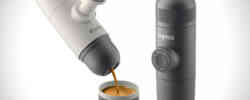Traditional camera shapes are wrong; such is the opinion of Jean-michel Bonnemoy, a designer par excellence. The statement or the opinion implies that every camera we have around us today, from the classic Nikon and Polaroid or the Brownie to the modern DSLRs, have a wrong shape or form. The argument Bonnemoy puts forth is almost convincing.
The conventional shape of camera was not an imaginative step but a realistic one, which was actually a compulsion. Cameras needed films and there had to be a place to hold or contain that film. Thus was the need for the flat square or rectangular backs. Albeit films became smaller and cameras became sleeker over time, the basic concept of designing a camera or the shape did not evolve much. There was certainly no revolutionary breakthrough, until now.
The standard camera is difficult to hold and it certainly doesn’t boast of ergonomic efficiency. Besides, with the reliance on digital cameras, there is no need for films any more. Thus, the conventional shape is not only unnecessary but can also be easily discarded. Instead, as Jean-michel Bonnemoy suggests, the D-CAN concept makes more sense and certainly makes the cameras look better.
The D-CAN concept is based on the simple idea that a cylindrical form of a camera is much easier to grip, it can come with all the features and functions of conventional cameras, if not more, and portability, ergonomics, style and every other physical, functional and aesthetic attribute can be bettered. The D-CAN concept is not just for fun or for occasional photography. It caters to all the needs of professional photographers, and with greater ease.
There are also some advantages of the D-CAN design. It can have a large range zoom stabilized lens, a ring that can lock focal lengths and can also correct focuses with ease, there can be an extension cursor macro-photography, the electronic flash can be installed with the lens cap to keep the cylindrical form, the accessory shoe can also hold a microphone and remote control receive besides harboring the flash and there can be a screen at the back as well as a viewfinder not make things comfortable for photographers who have gotten used to such features.
Nothing is left out in the D-CAN design. Instead, there is room for additional features while at the same time the space required, shape and usage are all made more practical for the present times.



